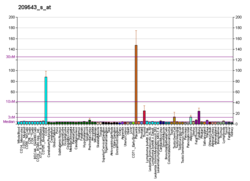
Back CD34 Czech Hämatopoetisches Vorläuferzellantigen CD34 German CD34 Spanish CD34 Persian CD34 Galician CD34 Italian CD34 Japanese CD34 Portuguese CD34 Russian CD34 Tatar
CD34 is a transmembrane phosphoglycoprotein protein encoded by the CD34 gene in humans, mice, rats and other species.[5][6][7]
CD34 derives its name from the cluster of differentiation protocol that identifies cell surface antigens. CD34 was first described on hematopoietic stem cells independently by Civin et al. and Tindle et al.[8][9][10][11] as a cell surface glycoprotein and functions as a cell-cell adhesion factor. It may also mediate the attachment of hematopoietic stem cells to bone marrow extracellular matrix or directly to stromal cells. Clinically, it is associated with the selection and enrichment of hematopoietic stem cells for bone marrow transplants. Due to these historical and clinical associations, CD34 expression is almost ubiquitously related to hematopoietic cells; however, it is actually found on many other cell types as well.[12]
- ^ a b c GRCh38: Ensembl release 89: ENSG00000174059 – Ensembl, May 2017
- ^ a b c GRCm38: Ensembl release 89: ENSMUSG00000016494 – Ensembl, May 2017
- ^ "Human PubMed Reference:". National Center for Biotechnology Information, U.S. National Library of Medicine.
- ^ "Mouse PubMed Reference:". National Center for Biotechnology Information, U.S. National Library of Medicine.
- ^ "Entrez Gene: CD34 CD34 molecule".
- ^ Simmons DL, Satterthwaite AB, Tenen DG, Seed B (January 1992). "Molecular cloning of a cDNA encoding CD34, a sialomucin of human hematopoietic stem cells". Journal of Immunology. 148 (1): 267–271. doi:10.4049/jimmunol.148.1.267. PMID 1370171.
- ^ Satterthwaite AB, Burn TC, Le Beau MM, Tenen DG (April 1992). "Structure of the gene encoding CD34, a human hematopoietic stem cell antigen". Genomics. 12 (4): 788–794. doi:10.1016/0888-7543(92)90310-O. PMID 1374051.
- ^ Civin CI, Strauss LC, Brovall C, Fackler MJ, Schwartz JF, Shaper JH (July 1984). "Antigenic analysis of hematopoiesis. III. A hematopoietic progenitor cell surface antigen defined by a monoclonal antibody raised against KG-1a cells". Journal of Immunology. 133 (1): 157–165. doi:10.4049/jimmunol.133.1.157. PMID 6586833.
- ^ Tindle RW, Nichols RA, Chan L, Campana D, Catovsky D, Birnie GD (1985). "A novel monoclonal antibody BI-3C5 recognises myeloblasts and non-B non-T lymphoblasts in acute leukaemias and CGL blast crises, and reacts with immature cells in normal bone marrow". Leukemia Research. 9 (1): 1–9. doi:10.1016/0145-2126(85)90016-5. PMID 3857402.
- ^ Tindle RW. Katz F. Martin H. Watt D. Catovsky D. Janossy G. Greaves M. (1987). "BI-3C5 (CD34) defines multipotential and lineage restricted progenitor cells and their leukaemic counterparts ". In 'Leucocyte Typing 111: White Cell Differentiation Antigens. Oxford University Press, 654-655.
- ^ Loken M. Shah V. Civin CI.. (1987). "Characterization of myeloid antigens on human bone marrow using multicolour immunofluorescence". In: McMichael, Leucocyte Typing III:White Cell Differentiation Antigens.Oxford University Press 630-635.
- ^ Cite error: The named reference
:0was invoked but never defined (see the help page).
© MMXXIII Rich X Search. We shall prevail. All rights reserved. Rich X Search




